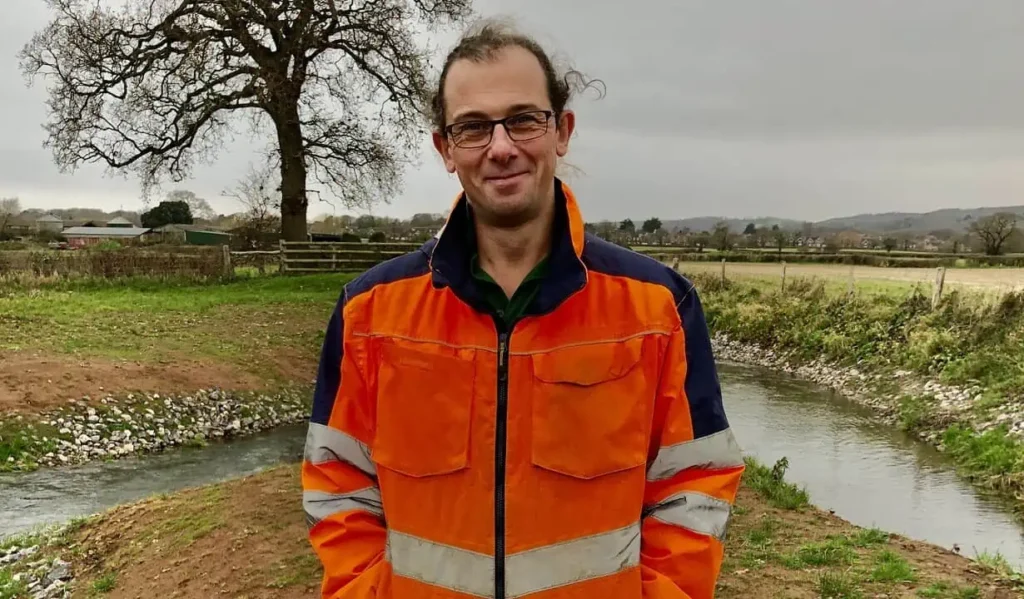On the 18th of December 2023 I was fortunate to be interviewing Nick May of Ecosulis. Nick is a Senior Project Manager and currently runs two separate teams for the company covering 10 sites. I interviewed Nick at the recently completed biodiversity project at Watercress farm for the Belmont Estate, in Bristol. The project ran from June to September 2023.
Nick has worked for Ecosulis for 10 years, working his way up from a temporary admin role to the role he now holds.
I asked him what challenges kept him up at night, while managing Environmental site projects. He said there were several “nervous breakdown points” in an Environmental project as he has to price, manage and follow up the jobs.

1. Tender stage
Nick’s biggest worry, is whether he will get the pricing correct or as close as possible (there are very few, if any certainties in the world of estimating). With Belmont, it was a new(ish) world for Nick and required a level of realism about how much spoil could be moved per day. For example, he estimated ~400m3 per day, and for the most part this turned out to be correct.
It is only once you start excavating, that you realise whether your initial assumptions were correct. As aways in the UK there were a couple of weeks when the weather was so wet that the rates of excavation and removal were low and for about 5 days no-one could work, (the excavators would have been picking up slop as the earth was so water logged and the wheeled dumpers getting stuck). In the good weather a tractor and 16t dump trailer and 10t Hydrema were used, but in bad weather you switch to a tracked dumper. However these are more expensive both in hire costs and fuel usage. In addition, access for them is always limiting given their size and the need to bring them in on low loaders and at Belmont this was the limiting factor. But ultimately all was well and the end result speaks for itself.
Roughly speaking an 11 tonne tracked dump truck costs ~£800 per day in total once all the fuel, operator and hire of the machine are factored in.
A few other things I consider is who else maybe tendering for the works, where are they based, as well as a very basic SWOT on them and the risks posed to you. And although for the most part many of us are friendly to each other there is still a job to do to win the works. I also consider whether or not we are best placed for the works, what supply chain we have locally (that local knowledge is worth its weight in gold) and what the end goal of the client is…
2. Contract stage
The next biggest challenge is getting the contract right, there are usually three options within the construction industry:
- NEC contract
- JCT contract
- JCLI contract
Generally speaking the contracts are meant to be collaborative which is especially the case for the NEC type contract however this may not always be the case and every company who works with them knows that they can also be used as a stick, and are maybe not as collaborative as the writers originally set out. On the Belmont estate project, Ecosulis and the estate agreed to have a “Memorandum of Understanding” instead of the usual contract, and this was a collaborative approach with no penalties. It made the project run very smoothly and everyone worked together with the end goal in mind.
3. Mobilisation stage
This is when the site is set up, the welfare units, and plant arrive. Getting everything in place to make sure you have everything the site teams need, access can sometimes change and can sometimes difficult to organise with minimum impact to the environment. Finding the right staff can also be a headache as there is only a handful of top drawer ecological/environmental site managers and staff available and sometimes they don’t live in the area of a site.
Experienced and knowledgeable 360 operators are particularly rare. With Belmont Nick was fortunate enough to have Mark Phipps, an owner-operator, based in the south of the UK, helping with the excavation of the new wetland as well as help from DJ Harrison, Lynch Plant Hire and Flannery’s plant hire.
4. Construction and Design changes
Normally, if Nick is asked to do extra work that is out of scope, during the project, “scope creep”, Nick discusses it with the team. When a design change is required, a technical query (TQ) is raised with the client and the change agreed, even on informal contracts its good practice to follow some very basic rules. With some changes this may cause a compensation event (CE) which would need to be agreed with the client where as some do not as you will see below.
Some view compensation events as a good thing and others see it as a bad thing. The CE process can be a time consuming and stressful process, which it shouldn’t be but can be and is just another form of communication along with requests for information (RFI), Early Warning Notices (EWN) and TQs. Even simple emails form part of what good communication looks like along with weekly onsite progress meetings (these make a massive difference and although aren’t new, walking the site with the client allows those small adjustments to be made early rather than via the more formal route).
An example of a good working design change process was at the Belmont estate. In the original design, the scrapes and large pond were designed as just bowls in the ground, so between the team onsite and Nick, it was discussed with the client and agreed that added extra shape and form be excavated which would result in areas that would become pools when cut off in the summer, by adding these extra contours and shapes.
On the Belmont estate, the design was created by another company, but the creation of these extra contours and shapes were absorbed within the construction costs, because it was the right thing to do to gain maximum ecological and biodiversity benefit from the project. Ultimately these changes will benefit the environment and future generations for years to come.
The benefits of the extra work, outweighs the negative of extra days of work. Nick knows that the development of wetlands will increase the carbon capture in the ground (carbon sequestered), as well as the removal of phosphates and the increases in biodiversity. This provides massive benefits to society.
Fairly early on during the works, the team onsite realised that the outflow of the new channel was ~2.5m higher than the design indicated due to placed dredgings from years of channel works. This resulted in an extra 200m2 of extra land which needed to graded resulting in a wider channel with shallower banks.
Whilst all existing land drains were broken to prevent the land from draining, there were a couple of the pipes left in to add to the drainage from one wetland cell to another.
5. Getting paid
This is normally another pain point, fortunately at Belmont, Nick described his clients as “dream clients” with very little disagreement over the approval of the Application for Payments (AFP) and the paying of the invoices.
6. Snagging and demobilisation
Getting offsite and tidying up the snagging list wasn’t much of an issue for Nick and his team (including his supply chain). With the ruts levelled and harrowed, and it is just a matter of time to return the land to what it was. The tracks left behind by the trucks and diggers have already grown over with grass and will eventually become as natural as they were when the team arrived.
It starts off with grass and weeds, and then eventually brambles appear and start to thickening the vegetation, which then leads to the development of more woody vegetation like self set trees (although the estate has also planted willow saplings along the new channel).

7. Looking back…
Nick’s biggest pain point in life is trying to educate people about how vital the natural environment is for our survival, and whether we will act fast enough to save the earth from the constant demand for resources whether that be water, food or metals and minerals.
8. The Future
In an ideal world Nick wants:
- People to stop treating the planet like it will be here forever.
- More emphasis given to wetlands, more wetlands to be created, and more understanding of the benefits of wetlands. It only takes two to three years for the benefits of carbon sequestration, phosphate removal and increased biodiversity to be impactful.
- People to stop thinking that planting trees will be enough to save the planet. They form part of the battle plan but are the solution by themselves, especially when you consider that wetlands absorb 3 times more carbon than woodlands and forests and provide massive increases in the biodiversity and phosphate removal from our broken watercourses.
If you need advice on your habitat creation or restoration project, Nick can be found at https://ecosulis.co.uk and on Linked-in at: https://www.linkedin.com/in/nick-may-67b70137/
Afterword: Not everyone can find recuperation easily for short term Environmental Restoration construction sites and Spodstore.com is in the business of providing a safe recuperation space (Sleep pod) for contractors at construction sites. What are your experiences of finding recuperation Sleep pods for contractors? Contact Nicole at admin@Spodstore.com or 07830786315 to discuss solutions or for further information.


